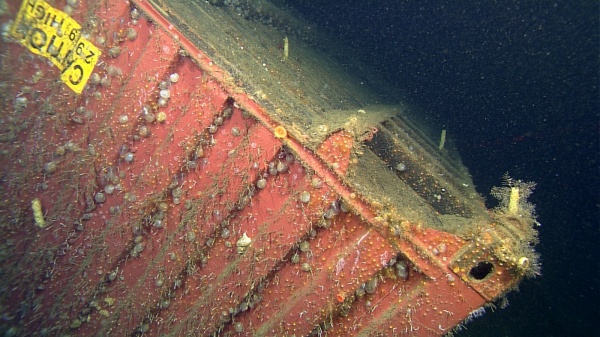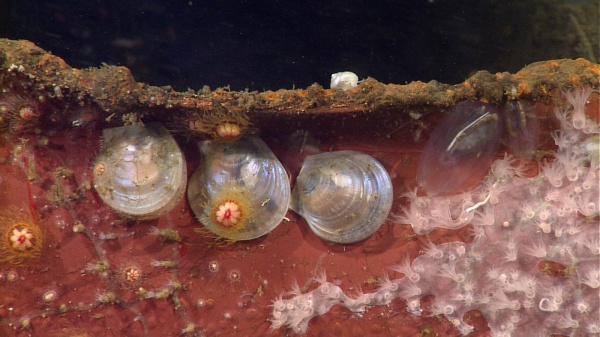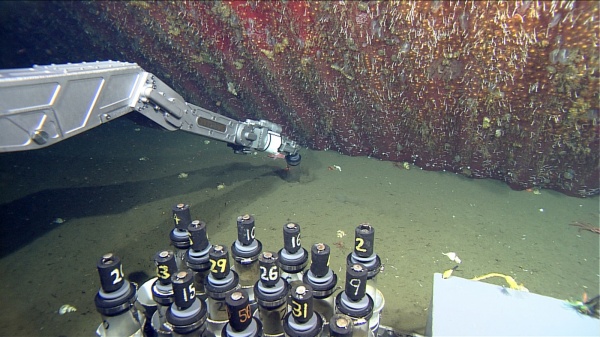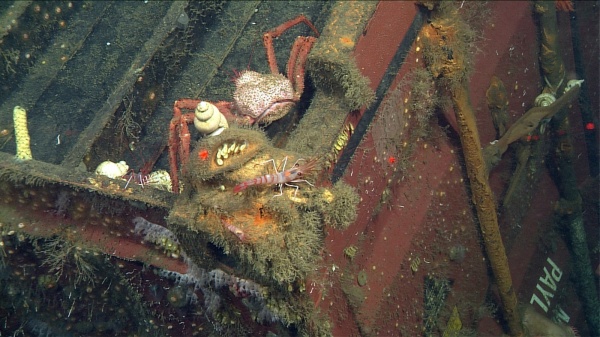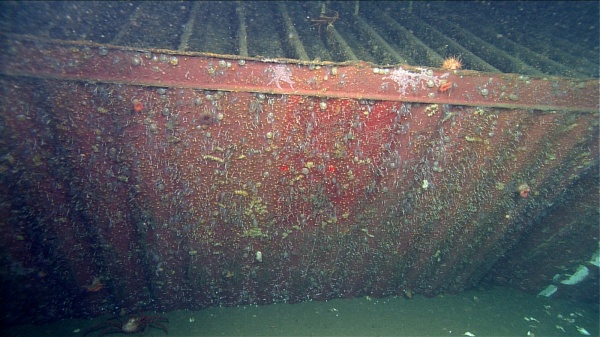Ecological Assessment of a Lost Shipping Container in the MBNMS
Overview
Principal Investigators:
- Andrew DeVogelaere
Monterey Bay National Marine Sanctuary - Jim Barry
Monterey Bay Aquarium Research Institute
Funding:
- Med Taipei Mitigation Fund
- Save The Earth
During a transit from San Francisco Bay to the Port of Los Angeles on 26 February 2004, the cargo ship M/V Med Taipei weathered a storm but lost fifteen 40-ft shipping containers in MBNMS, and another nine south of the sanctuary. One of these containers was discovered by the Monterey Bay Aquarium Research Institute (MBARI) on 9 June 2004 on Smooth Ridge at a depth of 1,281 meters, 17.5 nm NW of Point Pinos (Figure 1).
This was not an isolated incident. Containerized maritime trade grew eight-fold from 1985 to 2007, and worldwide there are now approximately 5 to 6 million containers in transit at any given moment. An estimated 10,000 shipping containers are lost at sea every year, often due to the nexus of rough seas and inadequate or faulty securing mechanisms. Many containers are not weighed prior to loading, resulting in extreme forces being placed on container stacks when bad weather strikes. Depending on the cargo, containers may float at the surface for several days or weeks prior to sinking. Unfortunately, it is not mandatory to report container losses to all relevant management agencies.
On 26 July 2006, a $3.25 million settlement with the vessel's owners and operators was announced for long-term damage to sanctuary resources. One of the diverse mitigation projects identified during the settlement negotiation process called for monitoring of the impacts, natural habitat recovery rate, and decomposition rate/characteristics of container TGHU7712262. In March 2011 and December 2013, a science team led by Dr. Andrew DeVogelaere (MBNMS) and Dr. James Barry (MBARI) conducted research expeditions aboard MBARI's R/V Western Flyer.
The remotely operated vehicle (ROV) Doc Ricketts was deployed to address the following goals: Assess the container's current condition by gathering high-resolution imagery; Describe sea life on the container and at different distances from it; Assess toxicity of paint that has chipped off of the container; Continue to bring public attention to this deep-sea phenomenon that has been increasing with economic globalization and increased shipping
Summary to Date
Visual surveys and biological community assessments using the ROV Doc Ricketts indicated that the fallen container has likely contributed to ecological impacts at three different scales: Upon impact with the seafloor, there was clearly an immediate crushing of any organisms present on the seafloor; Taxa on, and immediately adjacent to, the container were different from those that are further away, suggesting that the introduction of hard substratum caused local changes in ecology; and This and other lost containers comprise an expanding benthic footprint, which may be serving as hard substratum "stepping stones in the deep," facilitating the migration of species requiring hard substrate.
In addition, the container showed little sign of wear or decay after seven years at depth (Figure 4), however there was more observed growth (biota) on the container in the second visit in 2013. Released container contents – many of which are toxic – can cause contamination, but in this case the cargo of 1,159 steel-belted tires had not escaped. The thousands of containers already on the seafloor will likely be there for many hundreds of years and will be joined by thousands more each year, leading to high cumulative impacts.
Other findings included: The muddy sand seafloor at 1,281 m is a smooth seascape, with delicate tube worms every few inches, abundant lacey-white sea cucumbers, and red sea pens. We discovered an association between sea pigs (Scotoplanes) and juvenile lithodid crabs. Humans are impacting this deep-sea environment before we even understand what species live there and how the ecosystem functions. The container is showing signs of rust in damaged areas after 9 years on the seafloor. A scientific paper, currently under review, documents a 80 x 80 ft halo around the container where infauna were impacted.
Monitoring Trends
- The container shows some small signs of decay after 9 years at a depth of 1281 meters.
- Colonization of the container is limited to several species, but has increased from 2011 to 2013.
Discussion
Time demands placed on the shipping industry mean that safety protocols and securing methods have not kept pace with increasing container ship capacities. The navigational hazards and marine debris/contamination associated with container loss are already the subject of discussion in the European Union. In 2014, the U.S. Coast Guard proposed new rules for standardizing how cargo is secured on international shipping routes. Through research on a single container lost and found in the MBNMS, we have altered the global discussion on container loss by raising previously unaddressed issues.
Scientists, governments, and the shipping industry are now aware that in addition to container loss being a problem of trash on beaches and threats to human life, it is an issue of impacts to deep-sea ecology and potentially creating a corridor of habitat for spreading species in the depths below shipping highways. Because of the public's fascination with deep-sea exploration and the container's connections to the global economy and our own consumption, this story has captured the interest of people around the country and around the world. We are hopeful that this research can be used to leverage support for reforms to container securing regulations, to continue to educate the public about the beauty of the deep sea, and to increase awareness of the impacts of our own consumption.
Links
- Discovery Channel Canada, Daily Planet News Show
- MBNMS YouTube video on ship container loss, "Lost in the Deep"
- MBARI video of trash in the deep sea
- National Geographic article on 2013 visit to lost shipping container and Sur Ridge
- Monterey County Weekly article on 2013 visit to lost shipping container and Sur Ridge
- Lost Shipping Container and Benthic Ecology Cruise Log (Dec 11-16, 2013)
- Scientists To Give Lost Shipping Container a Second Look
- Boing Boing article about 2011 visit to lost shipping container
- NPR article and podcast about 2011 visit, "Lost, Then Found: Shipping Containers On Seafloor"
- Popular Science article about 2013 visit, "ROV Heads To Seafloor To Explore Lost Shipping Container"
- Images associated with the lost shipping container research expeditions of 2011 and 2013
- Frey, Oren, and A.P. DeVogelaere. 2013. The Containerized Shipping Industry and the Phenomenon of Containers Lost at Sea. Marine Sanctuaries Conservation Series ONMS-14-07. U.S. Department of Commerce, National Oceanic and Atmospheric Administration, Office of National Marine Sanctuaries, Silver Spring, MD. 51 pp.
Study Parameters
- Habitat
- Diversity
- Dispersal & Recruitment
- Range/Biogeography
- Habitat association
- Non-indigenous species
- Disturbance
- Predation
- Competition
- Abundance
- Distribution
- Density
- Temperature
- Salinity
- Substrate characterization
- Geological characterization
Study Methods
Visual surveys using ROV Doc Ricketts Biological community surveys Assessment of macrofauna and megafauna on and around the container Analysis of chemistry and grain size of sediments at different distances from the container with the use of push cores Assessment of macrofauna living within sediment near and far from the container with the use of push coresFigures & Images







Related Information
Photo Library
Click on an image below to view a larger version in the SIMoN Photo Library. You will also be able to view important information on each photo such as photographer, date, caption and more
